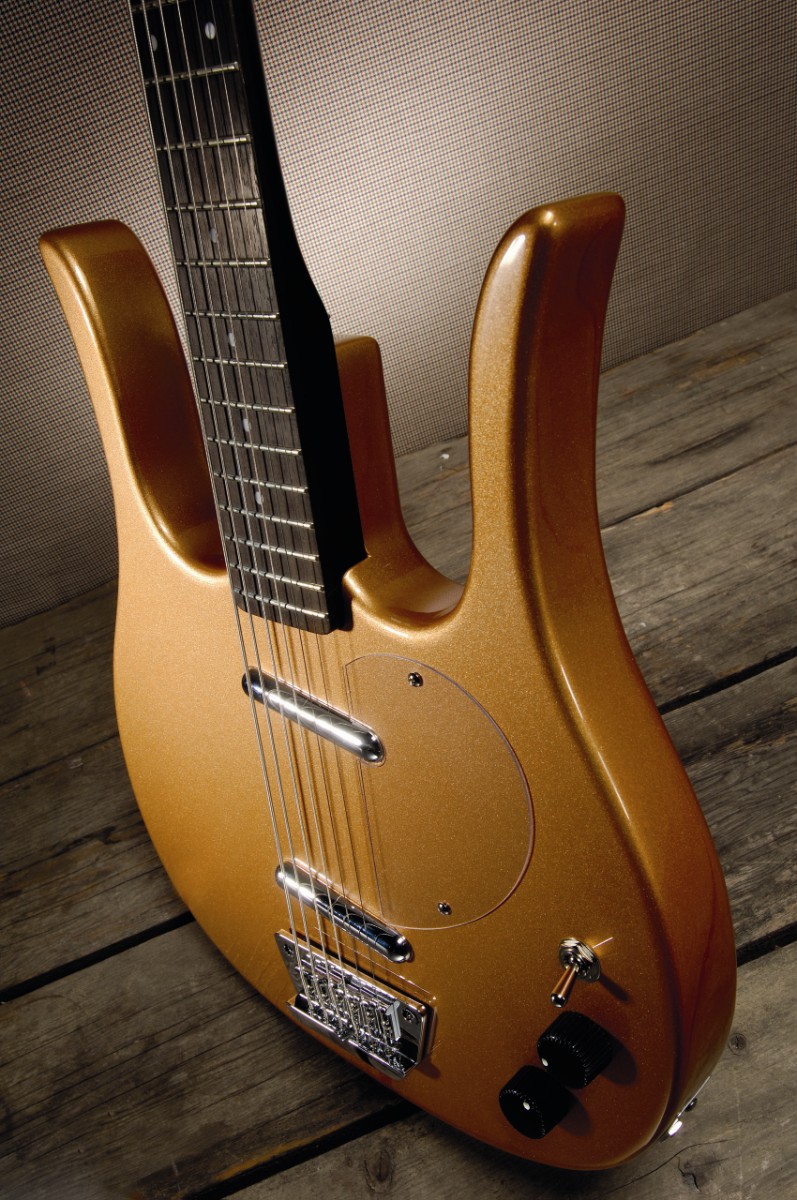MusicRadar Verdict
The retail price seems a touch excessive, but you are buying into an aesthetic as much as anything. This remains one of the bravest statements in electric guitar history.
Pros
- +
A baritone that isn’t just a metal machine. Cool gold finish…
Cons
- -
... though more finishes would be nice. It's neck heavy.
MusicRadar's got your back


Back in 2005, we were pleased to see the return of Danelectro electric guitars after a brief production hiatus. Rather than a straight reissue, that year's '56 Pro featured a number of hardware upgrades that improved the basic performance and reliability of the instrument immeasurably.
Admittedly we're not talking PRS-style manufacturing values here, but for £299 the '56 Pro displayed a great balance between gig-friendly reliability and the slightly clunky idiosyncrasies that are part of the Dano charm.
In 2006, Danelectro turned its attention to one of its maddest guitar designs ever: the Longhorn. There's a bass, a guitar and this baritone guitar, one of the company's trailblazing designs which was the brainchild of Duane Eddy back in 1958. No left-handers are available, although the symmetrical lyre-shaped body outline and central strap button placement are leftie friendly should you wish to flip the guitar around Jimi-style.
All three deisgns share common features idiosyncratic to Danelectro, such as the arguably wear-prone aluminium nuts and transparent plastic scratchplates secured by just a pair of screws. This results in the scratchplates of all three instruments flapping around and coming away from the body a little, but on the plus side it allows for plenty of picks to be stowed around the edges when it comes to gigging the things.
Body construction is identical to the updated '56 Pro, with a laminate frame capped with Masonite (hardboard) top and back. In our review of the '56 Pro, we found accessing the guitar's electronics to be fiddly on account of a Formica back panel being secured by a single screw into a floating piece of hardboard. This time around a chromed metal panel is used, fastened with a pair of screws, with better results. But as the panel itself isn't countersunk in any way, we worry that its edges might tear or snap your stage wear when the Longhorns are strapped on. That said, the distressed look is in this season and torn threads can only increase your Danelectro-toting indie kudos.
For the Baritone, you could argue Danelectro have simply taken the Longhorn bass, changed the nut and bridge, fitted six strings and tune them from B to B, and hey presto... the proportions are all otherwise identical. Where there's an almost toy-like feel to the standard Longhorn six-string, the Baritone's longer scale and heavier string gauge add girth to the feel and sustain to the guitar's acoustic response, making it feel like an altogether beefier proposition.
In terms of balance, it's a little neck heavy, but in all honesty a Danelectro Longhorn is never going to excel in this area; a unique guitar such as this will inevitably require some concessions in practical terms.
Want all the hottest music and gear news, reviews, deals, features and more, direct to your inbox? Sign up here.
Sounds
Many players' first instinct when encountering a baritone electric is to pile on the preamp distortion and chug out those metal riffs, but there's much more than that to be explored here. Unlike many humbucker-loaded modern baritones that are voiced for deep riffing, the natural brash twang of the twin Lipstick pickups means that it is an effective all-rounder for everything from surf runs to moody post-rock arpeggios. One of the strange effects of playing the same shapes a fourth lower is that even rather mundane chord changes and riffs are given extra weight and sound altogether more interesting for it. Treated to a dose of amp drive, the Lipstick pickups contribute to a sound that's clearly more scuzz-rock and grunge than nu-metal; try the neck pickup and a fuzz pedal for obscenely raunchy riffs on the low B string.
MusicRadar is the number 1 website for music makers of all kinds, be they guitarists, drummers, keyboard players, djs or producers...
GEAR: We help musicians find the best gear with top-ranking gear round-ups and high- quality, authoritative reviews by a wide team of highly experienced experts.
TIPS: We also provide tuition, from bite-sized tips to advanced work-outs and guidance from recognised musicians and stars.
STARS: We talk to musicians and stars about their creative processes, and the nuts and bolts of their gear and technique. We give fans an insight into the actual craft of music making that no other music website can.
